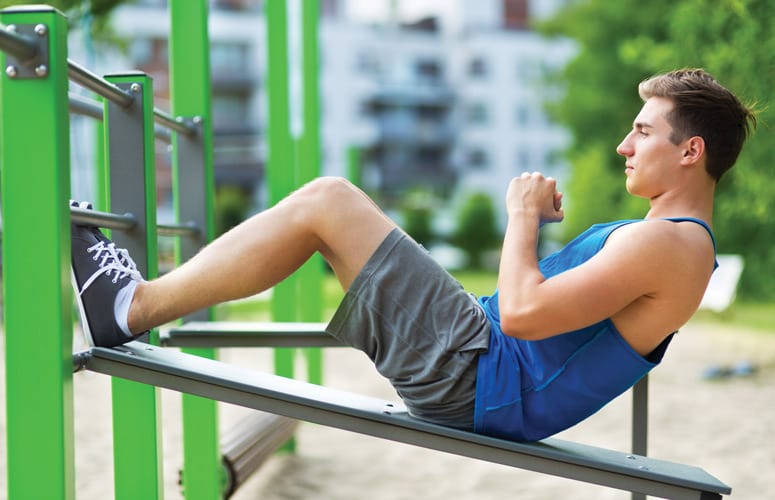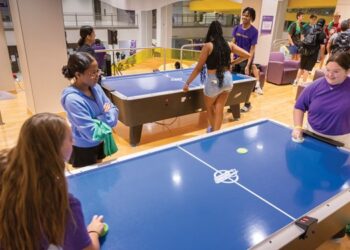A refreshing alternative to traditional workout spaces, the outdoor gym concept has been gaining popularity on campuses across the country. These unique amenities don’t require any overhead costs or staffing, provide exercise options to students that might feel intimidated by an indoor gym, and carry the added psychological benefits of time spent in the outdoors.
Every campus is unique. Therefore, the gym should be thoughtfully designed with the whole community in mind. There are several key aspects to consider when designing a gym and selecting a product.
The most appealing outdoor gyms incorporate not only the fitness aspect, but also social interaction. A gym design with all units arranged in a cluster, rather than spaced out along a path or trail, will encourage socialization; gyms that allow students to exercise alongside their peers will typically see more users, and those users will tend to exercise for longer periods of time.
Besides locating multiple pieces of equipment in the same area, incorporating multi-user units is beneficial as well. There are many outdoor fitness pieces that accommodate multiple individuals; some larger fitness rigs can host a dozen or more users simultaneously.
To attract the widest variety of users and provide the greatest value for the campus, outdoor gyms should include activities for the various ages and fitness levels that frequent the campus. Some campus demographics may include large numbers of nontraditional students, or host community classes and events as well. In addition, faculty and staff may enjoy the opportunity to exercise in the outdoors.
Therefore, a good mix of many kinds of units will ensure the gym has something to offer nearly every potential user. Student athletes will enjoy the challenging, functional fitness-style workouts, and the outdoor fitness industry has evolved to accommodate this trend. Nearly every apparatus in an indoor gym has been replicated for use in the outdoors — from kickboxing pillars to cannonball pull-up bars, suspension training rigs to rope climbing stations.
Locating fitness rigs with these types of elements near sports courts and fields will offer expanded fitness opportunities to athletes. Customization of the rigs is often available, and can go a long way in ensuring the end result is tailored to the specific needs of the intended users.
In tandem with advanced functional fitness activities, apparatuses designed for stretching and range of motion can be used not just for warm-ups and cool-downs for athletes, but will also be enjoyed by the rest of the campus. Other types of units utilize bodyweight leverage systems, which accommodate a wide variety of users by harnessing the user’s bodyweight to provide resistance. Finally, units that provide user-adjusted resistance — generally in the form of a piston — will further enhance the versatility and appeal of the outdoor gym.
The gym should also be inclusive, able to serve both the able-bodied and those with disabilities. It’s important to note a gym may be “accessible” with respect to a legal definition, but not be truly inclusive. Even though a unit may be available for a wheelchair user to transfer to, that individual still may have difficulty doing so.
It’s important to include units that eliminate the need to transfer in the first place. By making sure to design a truly inclusive gym, campuses can help fulfill an often-unmet need for those with disabilities.
By designing a gym with social interaction, broad appeal and inclusiveness in mind, the area will be best positioned to serve as many as possible, becoming a highly-frequented and valued amenity that the whole campus population can enjoy together.
Finally, don’t forget to promote spirit by making your gym match school colors.
Allison Abel is the director of marketing for Greenfields Outdoor Fitness. For more information, email allison@greenfieldsfitness.com or call 888.315.9037 x 112.











